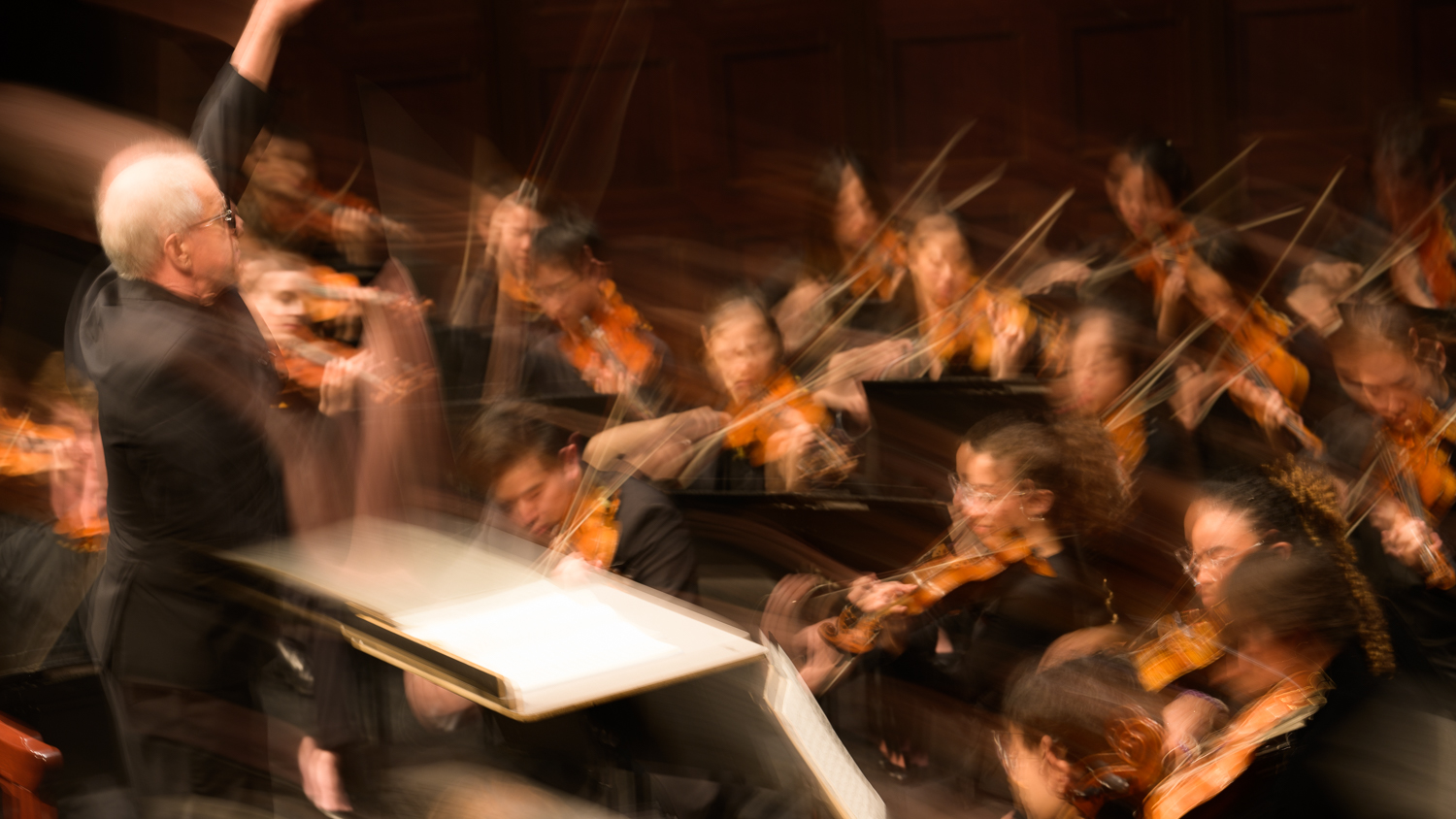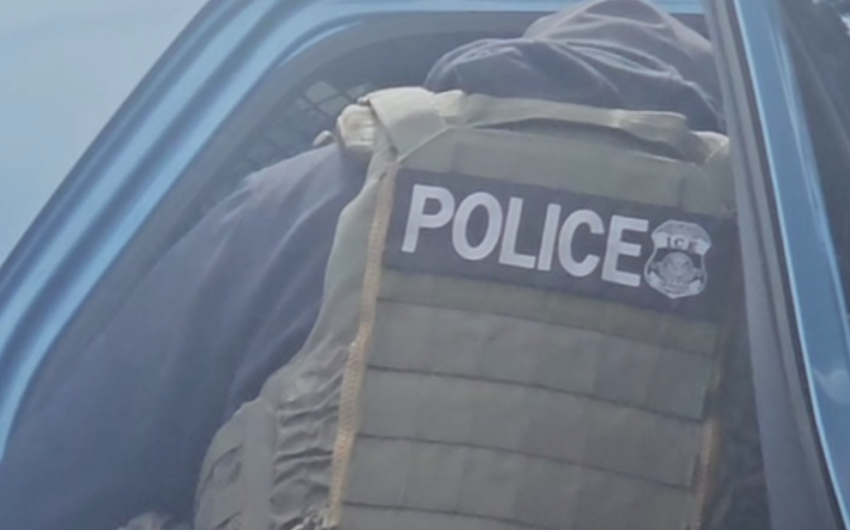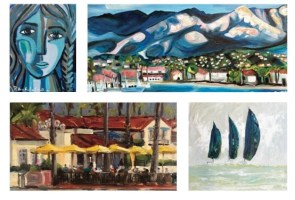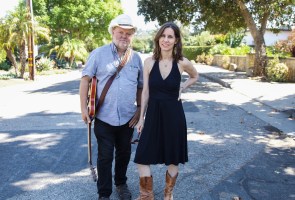ON the Beat | Denk Thinks, Feels Ives
In Music Academy of the West News, Pianist and Affable Thinker Jeremy Denk Memorably Unpacked Ives’ “Concord Sonata,” Leans into Duet with Joshua Bell on Monday

This edition of ON the Beat was originally emailed to subscribers on June 27, 2024. To receive Josef Woodard’s music newsletter in your inbox on Fridays, sign up at independent.com/newsletters.
After lapping up the diversions of Summer Solstice on Saturday — on parade and in various spaces around town — we were served up a hearty/heady triple shot of Wagner, Mahler, and Sibelius at The Granada Theatre, in the debut performance by this year’s Academy Festival Orchestra (AFO). Once again, the brand-new orchestra arm of the Music Academy of the West, boldly conducted by Osmo Vänskä, impressed on impact (read review here), and with this annual curtain-raising event, the Music Academy festival is officially up and running and luring local music lovers into its calendar-making clutches through early August.

Looking at the next week’s agenda, two significant tentpole events leap to mind. This Saturday’s AFO concert at the Granada, conducted by returning maestro Anthony Parnther, presents a rare chance to hear Stravinsky’s modernist masterwork Rite of Spring, anchoring a venturesome program along with the late Black composer Florence Price’s “Symphony No. 3” and the very much living composer Joan Huang’s “Tujia Dance.”
From the marquee-powered corner of the MAW calendar this year is the team-up of pianist Jeremy Denk and ever-popular American violinist Joshua Bell, joining forces for a “Mosher Guest Artist” concert at the Granada on Tuesday. Denk has been a critical staple and engaging force of the Academy faculty for several years now, but this will be the first Academy-related spotlight moment for Bell, whose latest Santa Barbara appearance was at the helm of the Academy of St. Martin-in-the-Fields Orchestra at the Granada in May. That enchanted evening featured an actual world premiere by Vince Mendoza, Flight of Moving Days, celebrating the centenary of the orchestra’s longtime leader, Sir Neville Marriner, and featuring his son Douglas Marriner swapping riffs with Bell in a jazz-circling-around-classical score.
The Denk/Bell encounter proceeds to the programmatic tunes of Mozart, Beethoven and, intriguingly, Stravinsky’s Divertimento (Le Baiser de la fée) (listen here), and more TBA.
Not to be outshined into an obscure corner, a second “Mosher” concert hits Hahn Hall on Tuesday, featuring the esteemed and returning cellist Steven Isserlis (with pianist Connie Shih), with a savory program of Beethoven, Nadia Boulanger, Thomas Adès, and an early taster of Fauré. Fauré is the subject of a special evening, at Hahn Hall on Friday, July 5, in which Isserlis joins the Denk/Bell team and violist Richard O’Neill for The Fauré Project, honoring a century since that famed Frenchman’s death.

Denk/Ives-ian Foray
In other birthday-linked news, clearly one of the highlights of this year’s festival settled into the cozy confines of the Miraflores Estate’s Lehmann Hall last Wednesday. In this epic, parlor-like space, Denk paid tribute to great American maverick Charles Ives’s 150th birthday with his utterly fascinating unpacking of Ives’s masterpiece solo piano work, the Concord Sonata. His unpacking process including not only a rapturous yet exacting performance of the challenging opus, one of the more important and singular piano sonatas by an American composer, but served up one of Denk’s trademarked erudite-yet-entertaining mini-lecture/demonstration tours through the piece.

Denk, once a famed blogger and with an acclaimed book out — Every Good Boy Does Fine: A Love Story, in Music Lessons (2022) — thinks and talks about music in ways that defy category or stuffy musicological blather, which explains why he came to the stage and grinningly balked at the listing of his pre-performance talk as a “curated lecture.” “Those are two of my least favorite words,” he said, adding that, “I’m sure Ives would agree, he being opposed to strict schooling.”
Ives’s Piano Sonata No. 2, Concord, is a unique world unto itself, as piano literature of music generally goes, a sometimes wild and layered, sometimes meditative and melancholy adventure for the mind. His reference points hover around the 19th-century transcendentalists, with movement dedicated to more restless and detour-plotted movements for Emerson and Hawthorne, a mellower, parlor-suitable ode to “The Alcotts” and finally the misty musings on Walden Pond of his “Thoreau” movement, ending with an unanswered question of a five-note motive to end — in suspension.
Yes, there are plenty of Ives-ian pileups and feints as the music incorporates the controlled chaos of polytonality (what Denk referred to as “Dagwood Sandwich chords”) and memory-bankrolled quotations from classical music, hymnody, folk tunes and sonic abstraction, but there is also a yearning beauty to much of Ives’s writing here, and in his overall oeuvre. As Denk said, “he’s not just a bad boy; there are some beautiful moments in there.” By “in there,” he’s referring to diving into the strong “thereness” of the Concord Sonata.
Denk also pointed out many of the fleeting references slyly tucked into Ives’s score, including nods to the five-note thunder of Beethoven’s Fifth Symphony, Wagner’s Tristan und Isolde theme, his oft-quoted popular tune “Columbia, Gem of the Ocean” (which the pianist warned is a hint that “madness is coming”), his father’s favorite tune, Stephen Foster’s “Down in the Cornfield,” and even the gently tolling bells of downtown Concord.
At “lecture’s” end, Denk summed up by noting, “I get the feeling that, for Ives, writing was not as important as listening.” After a quick break, Denk lived up to the essence of that statement, delivering one of the finest, most detailed but always game and juiced-up performances of the score I’ve ever laid ears on.
My Solstice Parade Daze, the Short Version

I get to the Alameda Park compound by noon-ish, lurk about the booths and vendor grub outlets. On the “speed parade” plan (start at the top and walk down to the end), I take in the 50th annual Summer Solstice Parade, that community unleashed campaign pagan sun worship ritual resplendent with the dancing floats and costumed citizenry suspending reality for a couple of blissful hours. Musical elements include Latin grooves (hey, there’s my old percussionist pal Lorenzo Martinez!) and a large Hare Krishna caravan with some interesting microtonal singers in the circumambulatory ensemble (don’t know any of those folks).
Back at the Alameda mainstage, I check out some music, including the quite fine, maybe Sheryl Crow–ish (or name your influence here) band Ali Angel.

Early evening, head over to the annual (and growing) Solstice Block Party on the Westside’s Robbins Street, take in the splendor on the asphalt, with good vibes for all ages, a tasty food spread, and tasty Grateful Dead–ish band sounds of the JG Mystery Band (rooted in the Jerry Garcia Band songbook) emanating from stage flowing with tie-dyed fabric and fettle.
After the Music Academy orchestra concert, pop by Roy to catch a rare set by the hopelessly well-dressed and well-rehearsed band Key Party (the band, as the sign reminds). Voilà, another Solstice, another blast of relative bliss in a world whose darkness can wait for a day or so.
Premier Events
Fri, Jan 31
5:00 PM
Santa Barbara
Artist Talk at Art & Soul on State Street
Tue, Jan 28
5:00 PM
Zoom
Fire Safety Community Zoom Meeting
Thu, Jan 30
7:00 PM
Solvang
Lucinda Lane Album-Release Show, at Lost Chord Guitars
Fri, Jan 31
9:00 AM
Goleta
AARP FREE TAX PREPARATION
Fri, Jan 31
5:00 PM
Santa Barbara
Artist Talk at Art & Soul on State Street
Sat, Feb 08
10:00 AM
Santa Barbara
Paseo Nuevo Kids Club
Sat, Feb 08
12:30 PM
Solvang
Garagiste Wine Festival
Tue, Feb 11
8:00 PM
Santa Barbara
SBIFF – Tribute to Timothée Chalamet
Thu, Feb 13
8:00 PM
Santa Barbara
SBIFF – Tribute to Adrien Brody and Guy Pierce
Fri, Jan 31 5:00 PM
Santa Barbara
Artist Talk at Art & Soul on State Street
Tue, Jan 28 5:00 PM
Zoom
Fire Safety Community Zoom Meeting
Thu, Jan 30 7:00 PM
Solvang
Lucinda Lane Album-Release Show, at Lost Chord Guitars
Fri, Jan 31 9:00 AM
Goleta
AARP FREE TAX PREPARATION
Fri, Jan 31 5:00 PM
Santa Barbara
Artist Talk at Art & Soul on State Street
Sat, Feb 08 10:00 AM
Santa Barbara
Paseo Nuevo Kids Club
Sat, Feb 08 12:30 PM
Solvang
Garagiste Wine Festival
Tue, Feb 11 8:00 PM
Santa Barbara
SBIFF – Tribute to Timothée Chalamet
Thu, Feb 13 8:00 PM
Santa Barbara




















You must be logged in to post a comment.